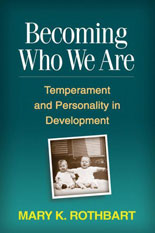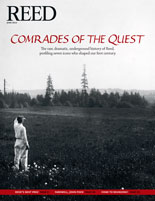
IRIS login | Reed College home Volume 91, No. 2: June 2012
Reediana
Becoming Who We Are: Temperament and Personality in Development (The Guilford Press, 2011)
Mary Klevjord Rothbart ’62
Reviewed by Angie Jabine ’79

An emerita distinguished professor of psychology at the University of Oregon, and the winner of the American Psychological Foundation’s 2009 Gold Medal Award for life achievement, Mary Klevjord Rothbart is considered by many to be the world’s foremost expert on temperament. In 1982, she introduced the Infant Behavior Questionnaire, based on parents’ reporting on their own children, which is now among the most widely used measures of infant temperament.
Rothbart encapsulates what she calls “the learning of a lifetime” in this treatise on inborn personality traits and how they persist, develop, or diminish in the face of varying parenting styles, social mores, and other life circumstances. As any observant parent knows, even newborns vary in how readily their emotions, motor activity, and attention are aroused (which Rothbart calls “reactivity”), and in how much control they exercise in dealing with this arousal (which Rothbart calls “self-regulation”). Rothbart describes these infantile temperamental differences as the building blocks of future personality traits such as conscientiousness, sensation seeking, agreeableness, openness to experience, and shyness.
Recent decades have seen a wealth of longitudinal studies of temperament from infancy to adulthood. Drawing on research from China, Australia, France, Greece, Japan, the U.S., and half a dozen other countries, Rothbart cites evidence that some traits show strong persistence over time, including extraversion and social inhibition. The ability to delay gratification at age four (“you can have one cookie now, but if you wait, you can have two”) turns out to be highly predictive of future academic competence and adult goal-setting skills, regardless of intelligence.
Intended for researchers and students in clinical psychology, Becoming Who We Are deals forthrightly with the methodological challenges involved in charting human behavior, and also includes a brief survey of the neurological research into human and primate temperament. At the same time, it is sufficiently nontechnical to offer rich insights to any reader, but especially to parents and teachers.


LATEST COMMENTS
steve-jobs-1976 I knew Steve Jobs when he was on the second floor of Quincy. (Fall...
Utnapishtim - 2 weeks ago
Prof. Mason Drukman [political science 1964–70] This is gold, pure gold. God bless, Prof. Drukman.
puredog - 1 month ago
virginia-davis-1965 Such a good friend & compatriot in the day of Satyricon...
czarchasm - 4 months ago
John Peara Baba 1990 John died of a broken heart from losing his mom and then his...
kodachrome - 7 months ago
Carol Sawyer 1962 Who wrote this obit? I'm writing something about Carol Sawyer...
MsLaurie Pepper - 8 months ago
William W. Wissman MAT 1969 ...and THREE sisters. Sabra, the oldest, Mary, the middle, and...
riclf - 10 months ago